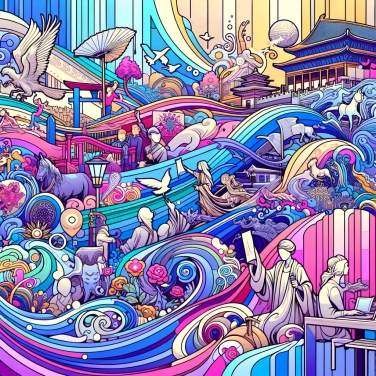The Egyptians mummified sacred animals because they believed that these animals were incarnations of the deities and that by mummifying them, they made them immortal and allowed them to continue serving the gods in the afterlife.

The sacred animals of ancient Egypt primarily represented embodied deities on earth. The Egyptians believed that a god could temporarily inhabit a specific animal to communicate directly with humans. Animals such as the cat, the ibis, the falcon, or even the crocodile were considered sacred, associated with certain deities like Bastet, Thoth, Horus, or Sobek. Respecting these animals meant respecting these gods. This closeness to the divine gave these creatures a special and sacred aura that justified their respectful treatment, veneration, and ultimately, their mummification after death.
The Egyptians believed that certain animals possessed a part of the divine. By mummifying these animals, they preserved the spiritual essence of the god within them. This also allowed them to facilitate communication between humans and deities. Mummifying a cat, an ibis, or a crocodile was a way of maintaining an intact sacred connection with the associated deities, a means of obtaining their blessing or protection. Moreover, owning or gifting a mummified animal could serve as concrete proof of their piety, a kind of VIP ticket to the goodwill of the gods.
The Egyptians approached animal mummification with almost as much care as that of humans. They often began by removing the internal organs, especially if the animal was large, such as bulls or crocodiles. These were cleaned and then stored separately, or sometimes replaced with packs of linen or sawdust to maintain the shape of the body. Next, the body was covered in natron, a natural product that absorbs moisture and prevents decomposition. After several days of rigorous drying, the final steps followed: the body was rinsed and coated with scented oils and resins to better preserve the tissues. In the end, the animal was carefully wrapped in long strips of linen and placed in a tomb or necropolis, ready to accompany its owner or serve as an offering to the gods.
Mummified animals often served as offerings to communicate with the gods or to seek divine favor. The Egyptians could purchase an animal mummy from a priest and then place it in a specific sanctuary to pay homage to the deity associated with the animal. For example, a cat mummy offered to the goddess Bastet could attract her protection over the one making the offering. These offerings thus allowed for the creation of a sacred bond between humans and the gods. Mummification made the offering durable and eternal, emphasizing the spiritual commitment of the faithful to their deities.
Archaeological excavations have uncovered thousands of mummified animals, ranging from the modest scarab to the sacred Apis bull, in Egyptian tombs and temples. Some sites, like the necropolis of Saqqarah, contained entire underground galleries filled with mummified animals—cats, snakes, ibises, crocodiles—stored in clay jars or in decorated sarcophagi. The diversity of species clearly shows their religious and also economic importance: there were even specific breeding farms dedicated to supplying animals intended for mummification. Thanks to modern scanners and advanced analyses, we now know that not all these mummies were equal: some actually contain complete and carefully embalmed animals, while others turn out to be mere containers stuffed with organic materials or bone fragments, sort of "cheap symbolic offerings." These discoveries reveal a very active religious and ritual trade where massive demand sometimes outweighed the rigor of sacred practices.
Archaeologists have discovered entire cemeteries exclusively dedicated to mummified animals in Egypt, some of which contain millions of animal mummies such as cats, ibises, and crocodiles.
The mummification of sacred animals was so common that it created a thriving industry in ancient Egypt, where entire temples were dedicated to the specific breeding of animals intended to become ritual mummies.
Among the sacred animals of Egypt was a bull named Apis, considered the living manifestation of the god Ptah. After its death, Apis received an elaborate mummification, followed by a sumptuous burial in special catacombs called Serapeums.
Some Egyptian animal mummies, when examined by X-rays, turned out to be 'fake', containing only a small part of an animal or merely plant material, sometimes showing that the symbolic ritual offering could take precedence over the actual contents.
Animal mummies were typically found in specific necropolises dedicated to certain deities or sacred animals, such as Saqqara for the Apis bulls, or in temples and sacred sites, either as offerings or accompanying human mummies.
No, while many mummified animals were indeed considered sacred and associated with a particular deity, others were prepared as simple votive offerings, without necessarily having an individual sacred character.
Animal mummification followed techniques very similar to those used for humans, including the removal of organs, dehydration with natron, and then careful wrapping and encasing in linen bandages, sometimes with the addition of amulets and ritual incense.
The Egyptians mass-mummified certain animals, primarily as votive offerings intended to honor the gods. Thousands of animal mummies could be created and placed in sacred deposition sites, which explains the considerable number discovered by archaeologists.
Although the basic steps were similar, the mummification of animals was often less elaborate and quicker, especially when done on a large scale to serve as votive offerings. However, some particularly revered sacred animals received treatments as careful and detailed as those given to humans.
The animals that were frequently mummified included cats, ibises, crocodiles, bulls (Apis), dogs, snakes, hawks, and monkeys, with each species associated with a specific deity and representing particular spiritual symbols for the Egyptians.

No one has answered this quiz yet, be the first!' :-)
Question 1/5